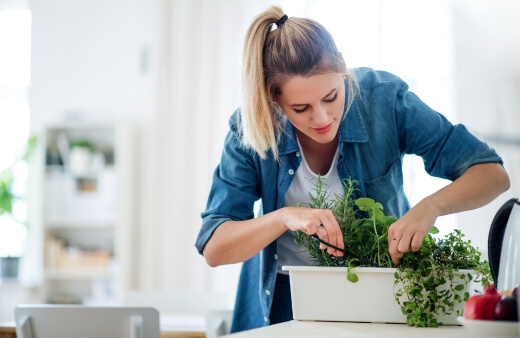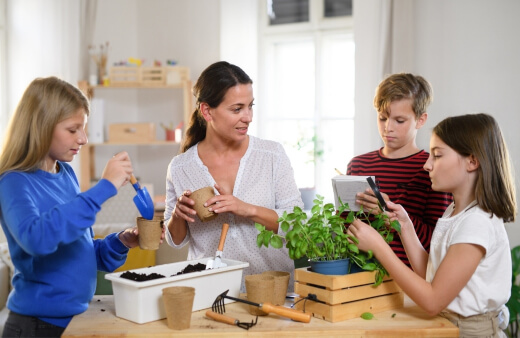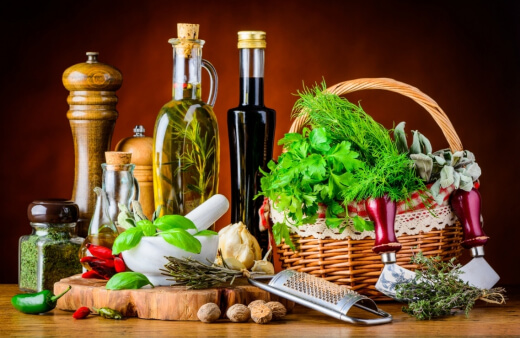Have you ever thought of growing herbs indoors? The time to bring your garden inside and give some new life to your interiors is here. There is plenty of talk nowadays about having environmentally safe and green homes, but there is a lot that needs to be done before you can make that a reality. Here is our guide on planting herbs indoors.
More...

Having a home filled with living plants will allow inhabitants to enjoy a time filled with natural beauty and calm. It is time to bring in some really nice indoor plants into your home.
There is a reason why a home closer to the natural world is a lot more pleasant to live in than others, as plants will help soften up rough edges, livening up boring and empty corners and so much more.
Modern interiors have simple and clean lines in so many households, but they don’t have to be that way unless you really want them to.
Having some excellent textural foliage and plants can help spice up an otherwise boring look, but you can also make a useful indoor garden, growing herbs for your cooking and domestic needs.
Don't miss our comprehensive guide on growing lights which would surely help you growing plants indoors.
Tips on Growing Herbs Indoors
Preparing the Soil
The first step for the job will need to be properly preparing your soil for your new plants. Work on digging the soil with a gardening fork to loosen it up and to make it more pliable and easier to dig up and work.
This will let water drain within the soil with greater success. This is an important first move as it happens to be necessary for plants to thrive anywhere.
Keeping Plants Healthy

If you want to keep your garden healthy and strong, then you will need to deal with irrigation to ensure the plants will have what they need. Most herbs will be pretty good by simply watering them as soon as the soil dries up a few inches below the surface of the soil.
You should avoid overwatering them, since the water may actually damage the roots and make the soggy conditions drown them if you go too far. Try to stay balanced in your efforts to lower the risk of rot and molds forming in the soil.
And speaking of soil, you need to be able to tell before planting whether the soil itself is too dry or too damp, because in case of the former, the plants could wither, and in case of the latter, they could rot.
A good way to tell is to scoop up a handful of soil from the grout at about root level. Squeeze the soil and observe. If the soil falls apart without forming a ball, it’s too dry.
If it does form a ball, but it keeps the shape as you continue squeezing or running a finger through it, it’s too damp.
If the soil is too dry, you should focus on more frequent watering and adding more compost or peat moss. And if it’s too damp, then you need to dig up the garden and add soil amendments.


Get Your Free Guide:
Master Growing Australian Natives eBook
A Must Have Complete Guide for Every Australian Garden
Get Your Free Guide:
Master Growing Australian Natives eBook
A Must Have Complete Guide for Every Australian Garden
(We previously endorsed peat/sphagnum moss. Yet, in consideration of its environmental repercussions, we've changed our recommendations to prioritize more sustainable alternatives that yield equivalent or superior results. Refer to our guide for an in-depth look at peat moss and its substitutes.)
Growing Herbs Inside Containers

Herbs will be easier grown for gardening purposes, so a warm and sunny corner of the place will be a good way to keep your plants healthy.
A patio can be a good compromise between growing plants outside and growing plants inside in a container. You can also use containers for mobility and apartment living in all cases. Planting and garden maintenance and more will be far easier by comparison.
Harvesting the Plants
This can be done fairly easily, just work on cutting up about a third of the branches whenever any plant reaches a height of more than 8 inches. Cutting close to the leaf intersection will let your plants grow anew, so you won’t have to worry about it.
Certain plants such as parsley will work on growing right from the center, which happens to be a requirement to remove the older branches and to let the new ones grow.
Are you looking to utilise your kitchen space for growing more food? If you are then check our comprehensive guide on mushroom growing kits in Australia.
Getting More Out of Herbs in Your Garden
The humble herb is more than just the pot of parsley lost in the corner of your backyard, or the old woody lavender that's been long forgotten. For many though, this is the extent of their use in home gardens.
Herbs can be so much more though! They're a great way of creating interest in a garden design and can be one of the most rewarding plants to grow.

You can grow herbs for food, for flowers, for foliage, as well as for their glorious fragrances, and sometimes for all those reason! So to help you get the most out of herbs in your garden, the first and most important thing you need to consider is this simple question - What do you want them for?
Here's a few tips to help you get the most of some common herbs in your home garden.
Herbs for Cooking
These are the herbs you're growing purely for food. Place herbs you're going to harvest in an easy to access area, where it won't matter if they've been cut down and harvested and look a bit shabby.
Herbs like lemon thyme, basil, vietnamese mint, betel, wasabi, and chives are obvious choices here and can be for a range of cooking dishes. They really enjoy a good cut back for harvesting and won't mind too much if you go a bit hard.
Putting them in pots or raised garden beds can make access a breeze, and save you bending your back.
Herbs for Show

You may want some herbs to plant for their flowers or colourful foliage and these should be planted in viewing distance from the high traffic areas of your garden, or from windows and doors so that you get the most out of their beauty.
Lining your walkways and paths with clumps of different flowering herbs, and using pockets of colour in amongst your other plants is a great way to create an eye catching feature.
It's best to use waves, clumps and pockets of plantings, rather than straight lines. These are easier to maintain, and add a sense of unstructured order to gardens.
Echinacea, nasturtiums, lavender, society garlic, and salvia are some of the best herbs to grow indoors with some amazing showy flowers.
If it is structure and order you're after, you can achieve the famous French parterre style garden design by using more sturdy herbs like rosemary, bay or wormwood and turning them into formal hedges.
Herbs for Lovely Fragrances

Placing herbs with strong and lovely fragrances in beds, indoor herb planters or hanging baskets in front of windows or upwind from entrances and doorways is the best way to go to ensure these aromas don't go to waste.
Lemongrass, lemon verbena, rosemary, and oregano can fill a breeze with some amazing smells.
Planting some tough ground covering herbs like chamomile and thyme in walkways can be another great way to get some extra scents floating about. Each step will lightly crush some leaves and release their aromatic oils.
By keeping your desired purpose in mind when you're growing herbs in your garden, you can get the most of your hard work and make some herbs a real feature in your home garden.
I was asked to share my expert herb growing opinion at Chefs Pencil, check out my tips here.
Published on June 2, 2022 by Nathan Schwartz
Last Updated on February 5, 2025




